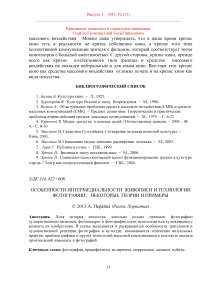The specificities of intermediality of painting and technology of photography: some theories and examples
Автор: Peraica A.
Журнал: Креативная экономика и социальные инновации @cesi-journal
Рубрика: Креативность действия в меняющемся Мире
Статья в выпуске: 2 (11) т.5, 2015 года.
Бесплатный доступ
Although history of art has recognized the photography as an art media quite late, photocamera and photographs were used by painters since the invention of the medium. Through the analysis of paintings based on photographs, the article distinguishes several specificities that photography has introduced into visual reception, changing the history of methods in painting, graphics and other visual media. These specificities are; a change to technical and monocular perspective, intriguing perspectives and view angles, effects of lens distortions, fragmentation of gaze, description through multiple details of time succession, atomization of a scene, deep counterlight and halation of objects in counter light, stillness without stiffness of posing, halted and frozen movement, unusual image cropping, perspective bokeh, combination printing and retouching.
Photography, pre-raphaelites, modernism, surrealism, dadaism, cubism
Короткий адрес: https://sciup.org/14239019
IDR: 14239019 | УДК: 316.422+008
Список литературы The specificities of intermediality of painting and technology of photography: some theories and examples
- See: Sumich, J.: Conceptual Fusion: Coleridge, Higgins, and the intermedium. (2007), Available online http://www.intermedia.ac.nz/pdfs/ConceptualFusionISBN.pdf. Accessed: 17.1. 2014.
- HIGGINS, D.: Intermedia, Leonardo, Vol. 34, No. 1 (2001), pp. 49-54
- WADE, J.N, ONO, H and LILLAKAS, L.: Leonardo da Vinci's Struggles with Representations of Reality, Leonardo, Vol. 34, No. 3 (2001), pp. 231-235
- LATTO, R. and HARPER, B.: The Non-Realistic Nature of Photography: Further Reasons why Turner was wrong, Leonardo, Vol. 40, No.3. (2007), pp. 243-247 5. Ibid.
- STEADMAN, P. Vermeer's Camera: Uncovering the Truth Behind the Masterpieces, Oxford University Press, 2001.
- Published by Gaston Tissandler in 1873.
- LATTO, R. and HARPER, B.: The Non-Realistic Nature of Photography: Further Reasons why Turner was Wrong, Leonardo, Vol. 40, No.3. (2007), pp. 243-247
- SMITH, L.: "The Seed of the Flower": Photography and Pre-Raphaelitism, Huntington Library Quarterly, Vol. 55, No. 1 (Winter, 1992), pp. 37-53
- SCHARF, a.: Painting, Photography, and the Image of Movement The Burlington Magazine, Vol. 104, No. 710 (May, 1962), pp. 186+188-195 11. Ibid.
- CHIARENZA, C.: Manet's use of Photography in the Creation of a Drawing, Master Drawings, Vol. 7. No 1. (Spring, 1969), pp. 38+45+91+92
- ARMSTRONG, C.: Reflections on the Mirror -Photography and the Self-Portraits of Edgar Degas, Representations, No. 22 (Spring, 1988), pp. 106-141
- George Friedrich Watts, 1912. Ibid.
- From Japanese boka, meaning blur.
- TUCKER, P.H.: Picasso, Photography and the Development of Cubism, The Art Bulletin, Vol. 64., No 2., (January, 1982), pp.286-299
- TUCKER, P.H.: Picasso, Photography, and the Development of Cubism The Art Bulletin, Vol. 64, No. 2 (Jun., 1982), pp. 288-299
- VERLON, Andre: Montage-Painting, Leonardo, Vol. 1, No. 4. (October, 1968), pp. 385 -392
- KRAUSS, R.: The Photographic Conditions of Surrealism, October, Vol. 19 (Winter, 1981), pp. 3-34
- ARMSTRONG, C.: Reflections on the Mirror -Photography and the Self-Portraits of Edgar Degas, Representations, No. 22 (Spring, 1988), pp. 106-141
- CHIARENZA, C.: Manet's use of Photography in the Creation of a Drawing, Master Drawings, Vol.7. No 1. (Spring, 1969), pp. 38+45+91+92
- HIGGINS, D.: Intermedia, Leonardo, Vol. 34, No. 1 (2001), pp. 49-54
- KRAUSS, R.: The Photographic Conditions of Surrealism, October, Vol. 19 (Winter, 1981), pp. 3-34
- KENNEDY J.M., and FIRENNE M.N.: Optics, Painting and Photography, Leonardo, Vol. 5, No 3. (Summer, 1972), pp. 285-286
- LATTO, R. and HARPER, B.: The Non-Realistic Nature of Photography: Further Reasons why Turner was Wrong, Leonardo, Vol. 40, No.3. (2007), pp. 243-247
- ROOSEBOOM, H. and RUDGE, J.: Myths and Misconceptions: Photography Painting in the Nineteenth Century, Netherlands Quarterly for the History of Art, Vol. 32, No 4 (2006), pp. 291-313z
- SCHARF, Aaron: Painting, Photography and the Image of Movement, The Burlington Magazine, Vol. 104., No. 710. (May, 1962), pp. 186+188+195
- SMITH, L.: "The Seed of the Flower": Photography and Pre-Raphaelitism, Huntington Library Quarterly, Vol. 55, No. 1 (Winter, 1992), pp. 37-53
- Creative Economics and Social Innovations STEADMAN, P. Vermeer's Camera: Uncovering the Truth Behind the Masterpieces, Oxford University Press, 2001
- THRO, E.B. Leonardo da Vinci's Solution to the Problem of the Pinhole Camera, Archive for History of Exact Sciences, Vol. 48, No. 3/4 (September 1994), pp. 343-371
- TRAVIS, D.: Before Photography -Painting and the Invention of Photography, Bulletin of the Art Institute of Chicago (1973-1982), Vol. 76., No 1. (January-March, 1981), p 7
- TUCKER, P.H.: Picasso, Photography and the Development of Cubism, The Art Bulletin, Vol. 64., No 2., (January, 1982), pp.286-299
- VERLON, Andre: Montage-Painting, Leonardo, Vol. 1, No. 4. (October, 1968), pp. 385
- WADE, J.N, ONO, H and LILLAKAS, L.: Leonardo da Vinci's Struggles with Representations of Reality, Leonardo, Vol. 34, No. 3 (2001), pp. 231-235
- i. THRO, E.B. Leonardo da Vinci's Solution to the Problem of the Pinhole Camera Archive for History of Exact Sciences, Vol. 48, No. 3/4 (September 1994), pp. 343-371


